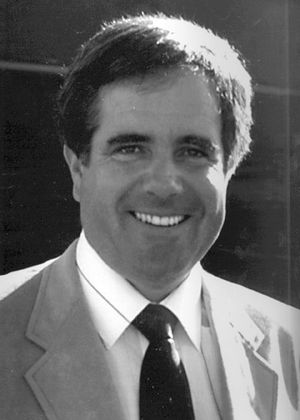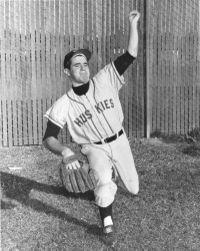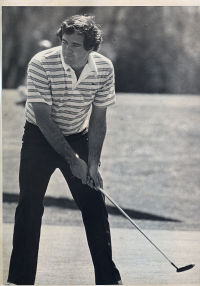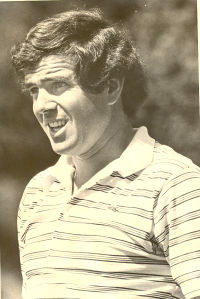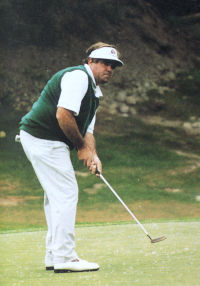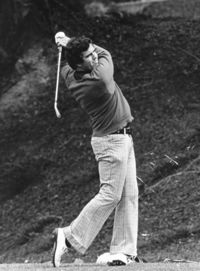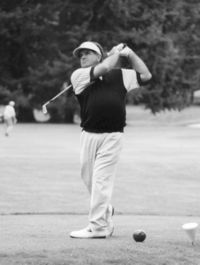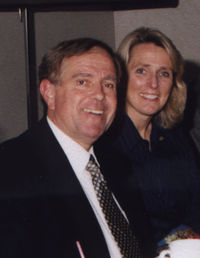Hall of Fame/Rick Acton
Inducted: 2000
Rick Acton was probably best known for his outstanding playing ability, and was considered one of the finest putters the game has known. His victories in the Pacific Northwest include 15 major championship titles. Rick was the head professional at Sahalee CC for twelve years, and during this time Rick developed a reputation as one of the finest club professionals in the Northwest. Rick was recognized by his peers as one of the nation’s finest teachers and he contributed countless hours toward making fellow professionals better teachers and players. He is the only professional in the Section’s history to be awarded four section awards—Teacher of the Year, Merchandiser of the Year, Horton Smith (now Professional Development) award, and Golf Professional of the Year. What Rick would like people to remember is not the putts he made or the titles he won, but his drive, competitiveness, and his tremendous respect for the game of golf.
Rick Acton: Competitor, Teacher, and a Humanitarian who rose above Personal Tragedy
by Bob Denney, PGA Historian Emeritus
What made Rick Acton one of the most accomplished and respected PGA Professionals in the Pacific Northwest PGA Section?
His competitive fire? An uncanny eye as an instructor? Perhaps it was more resilience mixed with pure love for his profession.
Throughout his life, Acton adapted and overcame major hurdles.
A natural southpaw and a standout pitcher at the University of Washington, he threw out his arm after signing a major league baseball contract with the Texas Rangers. This was before “Tommy John surgery” techniques became vogue and salvaged many pitchers’ careers.
Turning to golf, Acton earned a PGA Tour card, and played four years on tour before a life-changing automobile accident in the spring of 1976. The injuries he suffered pivoted him toward a PGA club professional career.
As he charted success in the Pacific Northwest PGA Section, he also had a separate passion. Though he never had children of his own, Acton gave back in a special way to brighten the lives of countless youngsters.
But, more about that later.
Born in Portland, Oregon, Acton and his family moved to Kirkland when he was a toddler. He inherited versatility from his mother, Donna, who ran the Flame Restaurant in Kirkland while her three children - Rick, brother Spencer and sister, Judi – were growing up.
Donna would later become Rick’s MVP in the golf shop when he became PGA head professional in 1984 at Sahalee Country Club in Sammamish, Washington. A natural left-hander, Acton played golf from the right side but putted from the left. And, he was lethal on the greens with the blade.
“Rick was a quality individual, one of the brightest people I’ve ever met, said Mike Davis, the PGA Director of Golf at DragonRidge Country Club in Henderson, Nevada. “He was one of the greatest putters ever. He wasn’t intimidated. When he was in competition, he wasn’t worried about who he was playing with. He was just playing his own game. That was not easy to do. While he was a great putter, the mental side might have been his strongest suit.”
“There was nobody more self-confident,” said PGA Life Member Bill Tindall of Redmond, Washington, who first met Acton when he arrived at Sahalee. “He was not a cocky guy, but a fierce competitor. When he was in the heat of competition, he loved it.”
Acton competed on the PGA Tour from 1973-80 with modest success, earning $9,670. His career was forever altered in a matter of seconds in 1976, when the car he was driving – what Davis said was a Datsun 280Z – was hit broadside by a driver peeling out of an AllState insurance parking lot not far from the Doral Golf Resort, which is some 12 miles northwest of Miami.
Acton and his passenger, PGA Professional David Glenz, who by coincidence also is a Portland native, were practicing that day at Costa del Sol Country Club near Doral. They were returning to the course after lunch.
“We were coming over a small bridge and your vision is partially obscured at one point,” said Glenz, now a PGA Director of Golf and designer/owner of Black Oak Golf Club in Long Valley, New Jersey. “The other car hit us almost head-on at 30 to 35 miles per hour.”
Rick’s car collapsed into him. This was more than two decades before airbags and other industry-mandated safety requirements were installed in U.S. automobiles.
“I broke the second metacarpal bone of my right hand, and I still carry a bump on it today,” said Glenz. “When the car stopped, Rick looked over to me and said, ‘I think I knocked all my teeth out!” Acton’s injuries were far worse. He received cuts to his face that required 250 stitches and also broke his jaw in six places. It was wired shut for 10 weeks. He also broke some ribs and injured both knees. Over the next decade he underwent five knee operations and played with a brace on his right knee.
Glenz said that he played several weeks after the accident in the Northwest Open.
“It was too soon to be returning to play and there really was a lot of emotion running through me at the time,” he said. Glenz went on to a successful teaching career, earning the 1998 PGA Teacher of the Year award. His biggest physical barrier, he said, happened two weeks before turning 50 when he broke his right hip skiing.
“Once Rick returned to the course, the effects of the accident bothered his ability to pitch, his wedge shots,” said Davis. “He couldn’t put weight on his front foot as he did before the accident. He would chunk or blade them for a long time.”
Rick’s wife, Debbie, who caddied for him in multiple events including the 1994 PGA Championship, recalled what her husband endured.
“For his entire life, there were small pieces of glass working their way to the surface,” she said. “At first, he thought it was a sore or acne. It would come out and then clear up. A lot of roadblocks were thrown his way, but he figured out a new way.”
Acton’s tenure at Sahalee Country Club was a combination of many joys, along with a legacy of giving back to both members and those he interacted with off the course. Debbie Coburn and Rick met in 1985 at Sahalee, where she was a member.
“He’s been gone for 22½ years and people at Sahalee still talk about his teaching ability,” said Debbie. “He’s still missed.”
Whether it was lunch or dinner, Debbie and Rick had a table overlooking the practice range. “Rick would see somebody doing something, and he could diagnose it from there. He’d walk out, give a 30-second conversation, come back and finish eating.”
Rick had an eye for going toward the root cause of what was going wrong. Instead of giving you 10 things, his knack was never looking at a person and saying that he was going to change a swing. He knew people’s swings. He had an incredible memory. One of my good friends used to open a driving range and used to call it ‘Rick’s Quickies.’ He said Rick could come by and in five minutes fix your swing and walk off.”
During one Senior PGA Tour in the 1990s in Park City, Utah, Lee Trevino played with Rick for two days in a row, and Lee had a good day on the course.
Later, they gathered at the practice range, and a large crowd gathered.
“Rick had helped Lee with something, but I don’t know what it was,” said Debbie. “Lee never admitted to taking a lesson,” said Debbie. “Lee stood on the range and said, ‘You know I don’t take lessons. I’ve never taken a lesson, but e. But if I did, it would be from that guy over there.’ And he pointed at Rick.
Debbie saide Trevino added, ” ‘Don’t be paying attention to me, watch that guy. He knows what he’s doing.’ ”
With Rick’s mother, Donna, managing the golf shop, Rick spent his time teaching on the range and freed him to travel to Section events.
Tindall recalled one moment where Acton was attempting to show off putting prowess.
“We were playing in a Northwest Open,” said Tindal, “and Rick’s ball came to rest on the fringe of the green in deep grass. Rick called out, ‘You got to see this,’ and he turned his putter on its toe. As he struck the ball, it bounced right up in the air near his face and landed on his foot. We all teased him, and he laughed about it.”
Two decades after the auto accident, Acton debuted on the Senior PGA Tour (now PGA Tour Champions). He tied for fourth in the Senior Tour Qualifying School, coming in having secured a leave of absence from Sahalee to pursue a career on the 50-and-older circuit.
He made a big splash, grabbing the second-round lead in the 1996 Royal Caribbean Classic at the Links of Key Biscayne. He posted a 67 to lead Hale Irwin and Bob Murphy by a stroke.
“I still consider myself a club pro who’s a guest out here,” Acton told the Sun-Sentinel.
A day later and in heavy wind, he finished five shots behind Murphy for solo third place. Despite the disappointment, Acton had proven he could make an impact among his talented peers.
Overall, Acton competed in five PGA Championships, the 1977 U.S. Open, was named one of the top 100 golf teachers in the country by GOLF Magazine, and won 18 significant Section championships. He competed on the 1986 and 1994 PGA Cup Teams; and eight PGA Professional Championships. His best finish was a share of eighth in 1993, which earned his trip to the ‘94 PGA where Debbie caddied for him.
Inducted in 2000 into the Section Hall of Fame, Acton remains the only Pacific Northwest PGA member to be decorated for Section Player of the Year (1994), Teacher of the Year (1988, ’89, , ’90, ’92), PGA Player Development (1996), and PGA Golf Professional of the Year (1994).
“I got to know Rick in the early 1980s. He was getting better as I was getting worse,” laughed PGA Life Member Jerry Mowlds of Portland, Oregon. “I don’t think many of us who didn’t spend as much time with him realized how much the accident affected him and what he had to overcome. We played a lot of golf together and attended a lot of teaching seminars.”
The Actons owned a gas station and deli in Conway, Washington. Donna helped run the station after Rick turned the golf shop over to Jim Pike, who was a shop assistant when he first met Acton in 1983.
Pike took another job in 1988, and in 1991, Acton approached him and said that he was going to try the Senior Tour and that Sahalee was going to get a PGA Championship, and that he would like Pike to return and become head professional.
Pike was elected to PGA Membership in 1992 and became Sahalee’s head professional two years later. Acton assumed PGA Director of Golf duties.
“Rick was a man of his word,” said Pike, now a PGA Life Member and retired from Sahalee in 2021. “He came back after a second year on tour and said, ‘Of all the things in life, being on tour is a great opportunity, but what I missed most were the great relationships, the staff, and members at Sahalee.’”
Said Pike, “the lessons I learned from Rick are infinite, but I will focus on his coaching expertise. Rick was an outstanding coach for players of all abilities. He often instructed PGA Teaching Professionals in our Section and at national summits as well.
“Rick did not teach for his own economic gain or for personal recognition, he always was there for his players.” Many days, said Pike, Acton would come into the golf shop in the morning and share with the staff the accomplishments of his students. “His students’ successes,” said Pike, “provided him more happiness and fulfillment than most of his own victories on the course.”
There was another layer to Rick Acton beyond golf, not immediately on display to the public that recognized him for his prowess on a course.
This side of Acton was magnified during the holidays and can be traced to Whidbey Island, just over 60 miles north of Seattle. The idyllic destination includes the 60-acre M-Bar-C Ranch, which was owned by Rick's stepfather, Dick Francisco, along with three others.
In December 1976, a letter that wasn’t delivered to Santa Claus at the North Pole, found its way to Francisco’s Restaurant in Seattle.
[The following letter contains a child’s original spelling]
"Dear Santa
Moma said you got lost last year and couldin’t find your way to our house.
We wrilly mist you aspeshly my little sisters
Please come this year Santa we are beaing very good
Moma sais youll get lost again maybe
so hear is a map
Love, Criag
ps. Don’t leav anything for dady, because he isn’t hear anymore."
The letter captured Francisco’s heart and the Forgotten Children’s Fund was born. After a few years, the ranch owners opened it to children with special needs or special circumstances, and their families.
The ranch was later sold to the Fund, an all-volunteer organization that provides holiday assistance to deserving families throughout the Greater Seattle area. The program provides everything a family would need to give children and their parents a memorable Christmas experience.
Each parent receives a small gift and food box with everything needed for a holiday meal. All of this is delivered directly to the homes Christmas Eve and Christmas Day by Santa and his elves. There are about 40 Santas and a few hundred elves on the team.
Rick Acton was one of the Santas on call.
“It was very important to him and it was wonderful to see a normally quiet man turn into a very jolly Santa,” said Debbie. “I have been involved with Forgotten Children's Fund for about 30 years and can't think of a better way to spend Christmas.”
Both Debbie’s children have been very involved since they were young, and Debbie has served on the Forgotten Children's Fund board for many years.
And, while few charitable organizations can say they don’t end with a one-stop magical moment, the Forgotten Children’s Fund goes the extra mile. It helps families with rent, utility bills, and repairs, and stays in touch with those it serves to provide additional support, if needed.
Acton found his resurgence on the formerly-titled Senior PGA Tour in 1996 and '97, earning $692,128. In addition to finishing third in his debut at the Royal Caribbean Classic, he was runner-up at the '97 Raley's Gold Rush Classic in El Dorado, California, finishing two strokes behind winner Bob Eastwood.
He was forced off the tour by ongoing knee problems that led to an artificial joint replacement. He was planning to rejoin the 50-and-older circuit until the spring of 1999 when he learned that he had cancer.
Through that difficult time, he remained upbeat, calling his diagnosis “a temporary setback.” That summer, Acton went ahead and married Debbie. It was his second marriage. In the final months of his life, Acton had given a friend a golf lesson, accepted an honorary membership from Sahalee Country Club, and even talked about playing again in the spring.
On Jan. 6, 2000, a day after his 54th birthday, Acton died from liver cancer. He was at Debbie’s home, just off the seventh fairway at Sahalee.
“The No. 1 thing about Rick was that he was the complete professional, said Jeff Ellison, former Pacific Northwest PGA CEO Jeff Ellison, who retired in 2020. “He was a great player that we all remember. He was a fantastic teacher, and was a great club professional dedicated to Sahalee. Finally, he was very committed to his fellow professionals, constantly sharing what he knew and offering any help that he could.”
Sahalee Country Club has what members affectionately call “the 28th hole,” a bar that has been christened “The Acton Room.” In this centennial year of the Pacific Northwest PGA Section, Acton wouldn’t approve of making a fuss over him. Debbie Acton confirmed as much when it was time for her remarks at Rick’s memorial service. “I wanted to speak, to say something,” she said. “But Rick would have been very upset with me if I cried or got overly dramatic.” So, Debbie wrote “Actonisms,” or as she told the audience, “was Rick.”
1. Course Management – Have a plan and stick to it, but if conditions change you need to be willing to adjust to those changes. This is the one thing where we have total control. Managing the course and your game put you in position to succeed.
2. There is no such thing as a bad break. If you waste time worrying about the supposed bad breaks, you miss the good ones.
3. What is the most important shot in golf? The one you are hitting right now.
4. Each shot is only as good or as bad as the next one. After hitting a bad shot then recovering to make birdie, Rick would often say, “I guess I laid up to the perfect spot.”
5. What do you need to do before every swing? Trust. You must believe the ball is going to go exactly where you are looking. (So look at the green not at the water)
6. It is not your best games that determine what kind of player you are, it is how you handle your worst games that show the true caliber of a player.
7. Be your own best friend. Some of the things we say to ourselves we would never say to someone else, even your worst enemy. Try positive self-talk, it works!
8. What is the most important rule in golf? Rick borrowed this one from his good friend, Bill Tindall, and over the years he realized more and more how important it was. The rule is very simple: When you have finished your round of golf, it will be considered a success if the people you played with enjoyed your company.
